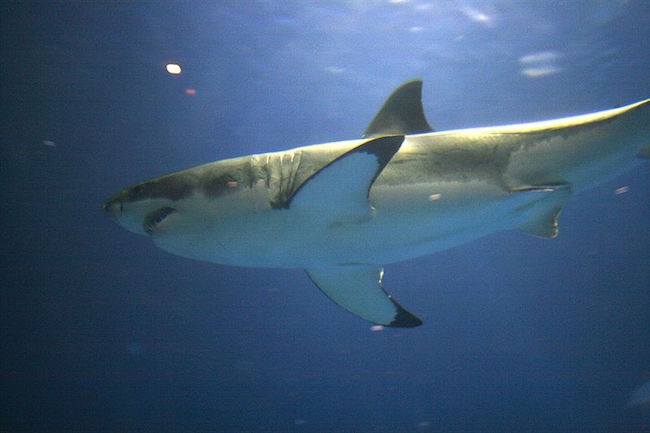
A great white shark exhibited at the Okinawa Churaumi Aquarium has been reported dead after just three days in captivity.
The great white, a 3.5 meter (11.5 foot) long male shark, had been caught in a fishing net off Yomitan Village in central Okinawa on January 4 and then moved to the Okinawa Churaumi Aquarium the following day .
The aquarium began exhibiting the shark that same day, and the news attracted considerable attention, as great white sharks, made famous by the best-selling novel and movie Jaws, are apparently extremely difficult to keep in captivity, due to difficulties related to the sharks’ feeding and swimming in a tank. The longest period a great white shark has been kept by humans seems to be the 198 days a young female shark was kept at the Monterey Bay Aquarium in California before being released back into the ocean in March of 2005.
According to the aquarium’s website, the shark appeared to be fine and was swimming in its tank without problem as of January 7, but its condition suddenly deteriorated on the morning of the 8th and the shark stopped swimming, sinking to the bottom of the tank. Despite efforts by aquarium staff and veterinarians, the shark did not recover and was reported dead later that day. During the time the shark was kept at the aquarium, it was the only great white shark on exhibit in the world, and it was hoped that this would be an opportunity to learn more about great white sharks, much of whose habits and life cycle still remains unknown. An investigation is currently underway to determine the precise cause of death.
Not surprisingly, the news of the shark’s death after such a short time in captivity has resulted in criticism from PETA ASIA, an affiliate of PETA (People for the Ethical Treatment of Animals). A comment from the organization’s Vice President Jason Baker stated, “The cause of death is clear: captivity. The shark never had to die like this.”
The unfortunate news seems to have evoked strong reactions, with plenty of comments online claiming that keeping any animal in captivity is tantamount to torture, and some even going as far as to criticize Japanese culture in general, including the practice of whale and dolphin hunting. At the same time, others have responded that animals dying in captivity is something that happens everyday and there are worse things happening out in the world to be concerned about.
However you feel about it, the death of the shark was certainly a tragedy, especially as so many people were thrilled to have the chance to see a great white shark in person when the aquarium first announced the exhibit. If we’re being honest, though, we can’t help feel that if presented with a live great white specimen, any aquarium in the world would find it difficult to release it immediately without first trying to study it at least for a while. But then, we guess that’s a dilemma that all aquariums and zoos, by their very nature, have to live with. Nevertheless, we’re certainly saddened by the untimely death of the shark.
Source: Mashable Asia via Associated Press, Okinawa Churaumi Aquarium website, Okinawa Times Plus
Top image: Wikimedia Commons

 Chance to feel a shark’s nards and more at Sunshine Aquarium’s “Lots of Sex” Exhibit
Chance to feel a shark’s nards and more at Sunshine Aquarium’s “Lots of Sex” Exhibit You can’t miss this amazing footage of a diver swimming in harmony with a giant whale shark
You can’t miss this amazing footage of a diver swimming in harmony with a giant whale shark Japanese town suffers population decline, turns its local elementary school into an aquarium
Japanese town suffers population decline, turns its local elementary school into an aquarium Aquarium provides fishy fun, horrifyingly awkward marriage proposals
Aquarium provides fishy fun, horrifyingly awkward marriage proposals Stay dry with Japan’s top 10 indoor attractions for rainy days, as voted by tourists
Stay dry with Japan’s top 10 indoor attractions for rainy days, as voted by tourists Disney princesses get official manga makeovers for Manga Princess Cafe opening in Tokyo
Disney princesses get official manga makeovers for Manga Princess Cafe opening in Tokyo Randomly running into a great sushi lunch like this is one of the best things about eating in Tokyo
Randomly running into a great sushi lunch like this is one of the best things about eating in Tokyo Beautiful new Final Fantasy T-shirt collection on the way from Uniqlo【Photos】
Beautiful new Final Fantasy T-shirt collection on the way from Uniqlo【Photos】 Is the new Shinkansen Train Desk ticket worth it?
Is the new Shinkansen Train Desk ticket worth it? Kyushu-exclusive Black Mont Blanc goes nationwide in a “Special” way
Kyushu-exclusive Black Mont Blanc goes nationwide in a “Special” way Hey, Japanese taxi driver! Take us to your favorite restaurant in Tsuruga City!
Hey, Japanese taxi driver! Take us to your favorite restaurant in Tsuruga City! New Pokémon cakes let you eat your way through Pikachu and all the Eevee evolutions
New Pokémon cakes let you eat your way through Pikachu and all the Eevee evolutions Osaka’s creepy cute mascot speaks for first time, adds more fuel the creepy OR cute debate【Video】
Osaka’s creepy cute mascot speaks for first time, adds more fuel the creepy OR cute debate【Video】 Japanese black curry “experiment” takes place at an unlikely restaurant branch in Tokyo
Japanese black curry “experiment” takes place at an unlikely restaurant branch in Tokyo We go looking for the free kaoyu hot spring facebath of onsen town Kusatsu【Photos】
We go looking for the free kaoyu hot spring facebath of onsen town Kusatsu【Photos】 Our Japanese reporter visits Costco in the U.S., finds super American and very Japanese things
Our Japanese reporter visits Costco in the U.S., finds super American and very Japanese things New Studio Ghibli bedding sets are cool in all senses of the word
New Studio Ghibli bedding sets are cool in all senses of the word We try out “Chan Ramen”, an underground type of ramen popular in the ramen community
We try out “Chan Ramen”, an underground type of ramen popular in the ramen community There’s a park inside Japan where you can also see Japan inside the park
There’s a park inside Japan where you can also see Japan inside the park Japanese convenience store packs a whole bento into an onigiri rice ball
Japanese convenience store packs a whole bento into an onigiri rice ball New definition of “Japanese whiskey” goes into effect to prevent fakes from fooling overseas buyers
New definition of “Japanese whiskey” goes into effect to prevent fakes from fooling overseas buyers Foreign English teachers in Japan pick their favorite Japanese-language phrases【Survey】
Foreign English teachers in Japan pick their favorite Japanese-language phrases【Survey】 Uniqlo opens its first Furugi Project secondhand clothing pop-up shop in Tokyo
Uniqlo opens its first Furugi Project secondhand clothing pop-up shop in Tokyo Studio Ghibli releases Kiki’s Delivery Service chocolate cake pouches in Japan
Studio Ghibli releases Kiki’s Delivery Service chocolate cake pouches in Japan Japan’s bone-breaking and record-breaking roller coaster is permanently shutting down
Japan’s bone-breaking and record-breaking roller coaster is permanently shutting down Toyota built a life-sized Miraidon Pokémon and are letting people test drive it this weekend
Toyota built a life-sized Miraidon Pokémon and are letting people test drive it this weekend Foreign passenger shoves conductor on one of the last full runs for Japan’s Thunderbird train
Foreign passenger shoves conductor on one of the last full runs for Japan’s Thunderbird train Kyoto bans tourists from geisha alleys in Gion, with fines for those who don’t follow rules
Kyoto bans tourists from geisha alleys in Gion, with fines for those who don’t follow rules Studio Ghibli unveils Mother’s Day gift set that captures the love in My Neighbour Totoro
Studio Ghibli unveils Mother’s Day gift set that captures the love in My Neighbour Totoro Domino’s Japan now sells…pizza ears?
Domino’s Japan now sells…pizza ears? New Japanese KitKat flavour stars Sanrio characters, including Hello Kitty
New Japanese KitKat flavour stars Sanrio characters, including Hello Kitty Sales of Japan’s most convenient train ticket/shopping payment cards suspended indefinitely
Sales of Japan’s most convenient train ticket/shopping payment cards suspended indefinitely Sold-out Studio Ghibli desktop humidifiers are back so Totoro can help you through the dry season
Sold-out Studio Ghibli desktop humidifiers are back so Totoro can help you through the dry season Japanese government to make first change to romanization spelling rules since the 1950s
Japanese government to make first change to romanization spelling rules since the 1950s Ghibli founders Toshio Suzuki and Hayao Miyazaki contribute to Japanese whisky Totoro label design
Ghibli founders Toshio Suzuki and Hayao Miyazaki contribute to Japanese whisky Totoro label design Doraemon found buried at sea as scene from 1993 anime becomes real life【Photos】
Doraemon found buried at sea as scene from 1993 anime becomes real life【Photos】 Tokyo’s most famous Starbucks is closed
Tokyo’s most famous Starbucks is closed One Piece characters’ nationalities revealed, but fans have mixed opinions
One Piece characters’ nationalities revealed, but fans have mixed opinions We asked a Uniqlo employee what four things we should buy and their suggestions didn’t disappoint
We asked a Uniqlo employee what four things we should buy and their suggestions didn’t disappoint Princesses, fruits, and blacksmiths: Study reveals the 30 most unusual family names in Japan
Princesses, fruits, and blacksmiths: Study reveals the 30 most unusual family names in Japan Studio Ghibli’s new desktop Howl’s Moving Castle will take your stationery on an adventure
Studio Ghibli’s new desktop Howl’s Moving Castle will take your stationery on an adventure Sunshine Aquarium’s 2022 lucky bag is a true rarity
Sunshine Aquarium’s 2022 lucky bag is a true rarity Art Aquarium returns to Tokyo with goldfish, beautiful lighting, soothing sounds, delicious sake
Art Aquarium returns to Tokyo with goldfish, beautiful lighting, soothing sounds, delicious sake Pata the Otter celebrates her 20th birthday with a photo exhibit!
Pata the Otter celebrates her 20th birthday with a photo exhibit! Autopsy results, cause of death released for Yu-Gi-Oh! manga creator Kazuki Takahashi
Autopsy results, cause of death released for Yu-Gi-Oh! manga creator Kazuki Takahashi Shark Cat entertaining Shark Baby while riding a Roomba? Why not!
Shark Cat entertaining Shark Baby while riding a Roomba? Why not! Japanese museum celebrates Golden Week by publicly dissecting rare sea creature 【Photos】
Japanese museum celebrates Golden Week by publicly dissecting rare sea creature 【Photos】 Fukuoka amusement park draws anger for skating atop 5,000 sea creatures frozen in ice
Fukuoka amusement park draws anger for skating atop 5,000 sea creatures frozen in ice Japan creates a hyper-intense fishing game that’s not for the faint of heart【Video】
Japan creates a hyper-intense fishing game that’s not for the faint of heart【Video】 Garden eels in Japanese aquarium are forgetting humans and need your help!
Garden eels in Japanese aquarium are forgetting humans and need your help! Japanese gamer shares images of most realistic Pokémon Go gym battle ever
Japanese gamer shares images of most realistic Pokémon Go gym battle ever Tokyo aquarium’s reopening showcases a revamped, ethereally beautiful jellyfish chamber
Tokyo aquarium’s reopening showcases a revamped, ethereally beautiful jellyfish chamber Coca-Cola Japan brings out a new design bottle exclusive to Okinawa
Coca-Cola Japan brings out a new design bottle exclusive to Okinawa Over 30,000 goldfish on display at Art Aquarium, Tokyo’s newest Instagrammable spot
Over 30,000 goldfish on display at Art Aquarium, Tokyo’s newest Instagrammable spot Over 1,000 fish and other marine creatures die at Tokyo aquarium after failed medical treatment
Over 1,000 fish and other marine creatures die at Tokyo aquarium after failed medical treatment These adorable animal cakes may be too cute to eat, but we’ll still try!【Photos】
These adorable animal cakes may be too cute to eat, but we’ll still try!【Photos】 New 3D aquarium show to let visitors experience a trip to the deep sea in Enoshima
New 3D aquarium show to let visitors experience a trip to the deep sea in Enoshima
Leave a Reply